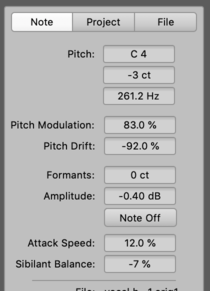The Note Inspector
The Note Inspector in the info pane offers you an overview of the parameters of the selected note(s) and allows you to alter the values.
The parameters of the Note Inspector
The Note Inspector brings together the inspector fields that are usually displayed near the toolbar when the various tools are in use. It allows you to see all the most important parameters at a glance and even edit them without having to change tools.

In addition to the data included in the inspector fields, the Note Inspector displays the frequency in hertz as well as a button for the muting of notes.
The editable parameters displayed in the Note Inspector are (from top to bottom):
- the pitch of the selected note in semitones, cents and hertz
- the pitch modulation expressed as a percentage
- the pitch drift expressed as a percentage
- the formant shift in cents
- the amplitude in decibels
- the button for muting and unmuting notes
- the attack speed expressed as a percentage
- the sibilant balance
Lower down in the inspector, you can see to which audio file the selected note belongs and which algorithm was used for the detection.
Entering values and handling multiple selected notes
When only one note is selected in the Note Editor, the Note Inspector displays the concrete values for that note.
As a general rule, you can modify all values either by clicking in their respective fields and dragging the mouse pointer upwards or downwards or by double-clicking in the field and typing in a new value.
In the case of the Pitch field, you can enter either an absolute (C3, D4 etc.) or a relative (+2, -1, etc.) value. In the other fields, it is always the absolute value that is adopted.

If you have selected multiple notes, the Note Inspector will only displays concrete values for parameters if these are shared by all the selected notes. Where values differ, a dash “–” is displayed in the relevant field.
If a dash is displayed, by clicking on it and dragging, you can alter the individual values of all the notes selected by the same amount; in this way, for example, you could transpose an entire selection up two semitones. The Scale Snap function, of course, if activated, will govern the eventual destination of the various notes.
As you drag the values, Melodyne remembers the difference between them. This is even true when certain parameters ‘collide’ with their maximum or minimum values; provided you keep the mouse button pressed and drag then in the opposite direction, the initial difference will be restored. Only if you release the mouse button at the point of collision will the initial difference be forgotten.
Alternatively, with multiple notes selected, you can type in a value that will then be assigned to, and thereafter shared by, all the selected notes (whereupon the dash, of course, will disappear).
An exception here is the pitch, as, if you type in the value “2”, for example, all the selected notes are shifted two semitones upwards. If you wish to assign the same pitch to all the selected notes, type in an absolute value, such as “C2”. If the Percussive or Universal algorithms are selected, of course, this has no effect, as these algorithms only know relative pitch.